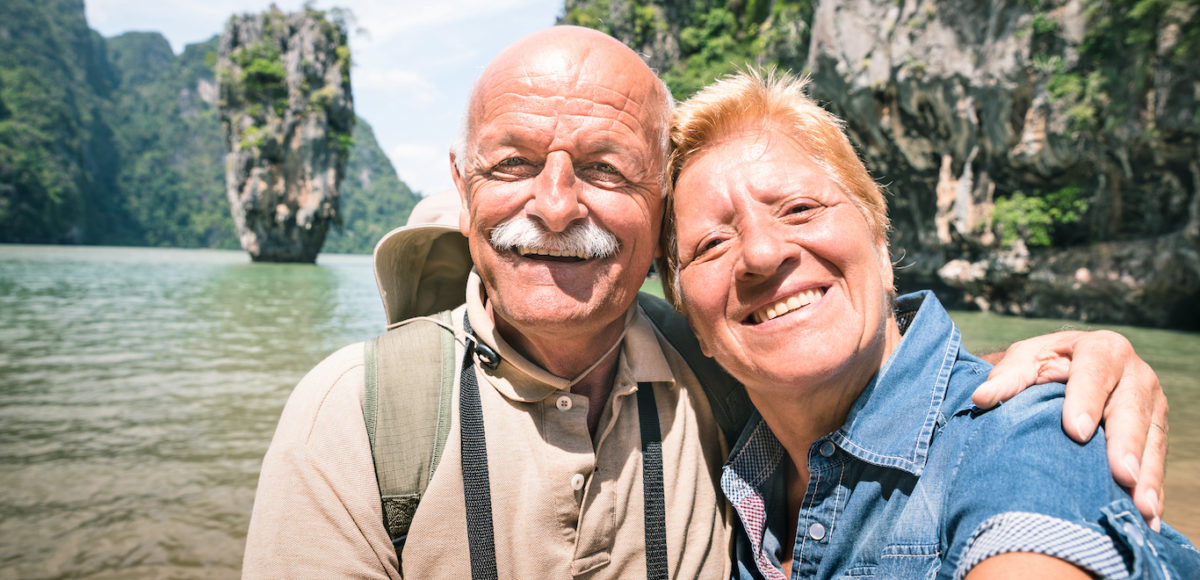Whether the kids are gone or retirement is finally here, you’re entering a new -and exciting- phase of your life. If one of your dreams for years has been to travel the world at your own leisure, here’s your chance! Make your wildest dreams come true with these tips for adopting the nomadic retirement lifestyle.
1. Start with Smaller Trips First
While experiencing tasty, new dishes and enjoying brilliant, picturesque landscapes can make the nomad lifestyle seem like a wanderlust dream; long-term travel can also come with its share of difficulties.
Many people have embarked on nomadic journeys, only to find that this lifestyle doesn’t quite suit them. For others, an initial plan to explore the world short-term has turned into years — or even decades — of adventure.
Our advice? Start small.
By taking shorter trips in the beginning, you can simulate what the experience might look like for you. Practice packing light, make note of any essentials you may leave behind, and identify any deal-breakers or preferences for living arrangements, locations, and health-related options. But most importantly, determine if the nomadic retirement lifestyle is something you’re willing to do for an extended period of time.
2. Evaluate Your Retirement Income
Now that you know the nomadic retirement lifestyle is right for you, it’s time to take a good long look at your retirement income. Your ability to sustain a life of long-term travel depends on your ability to fund it.
Check everything from your retirement savings, income taxes, investments, social security, and any other income you can use to fund your wanderlust adventures. Then, you’ll want to investigate what money is coming out of your account too.
Seek financial guidance from a consultant if you’re unsure about where you stand. And once you know how much money you have to work with, you’ll be better able to assess your travel budget.
3. Set a Budget
You know what you generally have to spend. Now, it’s time to set a budget. There is no one-size-fits-all strategy for planning your travel adventure in retirement, but we have a general guideline to get you started.
Make a detailed list of possible expenses (i.e., travel accommodations, transportation, activities and excursions, dining and groceries, etc.). Then, with your long-term income in mind, set a daily budget for each expense. You’ll also want to anticipate potential emergency costs (i.e., flights back home, medical visits, etc.) that may inevitably pop up on your travels.
And, of course, always allow for some fun financial flexibility too. You’ve worked hard to do retirement your way. It’s your right to enjoy it!
4. Create Your Wanderlist
Now that your finances are in order, it’s time to dream up some big plans! Where do you want to go? Which landscapes and monuments do you want to see? What cultures and food do you have to experience?
Shop for travel guides and read up on all of your wanderlust destinations. Daydream about what life would be like in each place. Once you’ve crafted your bucket list ideas for retirement, consider the logistics.
What is the cost of living in each location? Are these places able to accommodate your health requirements? By creating a bucket list, you can identify any non-negotiables. And once you’ve found the spots that speak to your needs and wanderlust spirit, it’s time to start planning!
5. Minimize Your Lifestyle
An inevitable truth of living the nomad lifestyle is that you will likely begin to treasure experiences over possessions. Shipping or lugging around unnecessary items and keeping up with costly home maintenance and mortgage payments can become both a hassle and financial burden. The solution — minimize your lifestyle.
For some, this might look like renting out or downsizing your home, selling or donating items you no longer need, and moving a few things into storage. For others, it might mean selling your house entirely and getting rid of most of your belongings in exchange for a fuss-free travel experience. But how much you downsize should be based on your planned length of travel.
For example, if you’re traveling for a year, it may not make sense to drastically downsize. But if you’re planning on being a nomad for the full extent of your retirement, it might be time to let a few things go. This decision is not to be taken lightly. Thoroughly examine the details, have conversations with your loved ones, and consult a financial advisor if needed.
6. Mind Your Health
While perfect health is not a prerequisite for living as a nomad, you want to make sure you have everything you need to travel safely. Speak with your doctor before relocating and moving around after retirement.
For instances where you’re not covered by Medicare or health insurance, consider getting travel insurance. Having this on hand can save you tons of money on health care and expenses. Shop around for reliable, cost-effective policies you can trust, and always read the fine print.
7. Monitor Your Expenses
While sipping the finest wine at a brasserie in Paris or splurging on that five-star hotel in Vegas, it can be easy to loosen the reins on financial discipline. To make sure you stay within budget, track your daily expenses. Keep tabs on what activities you do, how much you spend, and your average monthly expenses. This way, you know when to splurge and when to save.
8. Supplement Your Income
If you find it difficult to stick to your budget or want to increase your income, other options are available. According to Vanguard, nearly 20% of Americans, age 65 and older, report income from wages. This means that it may be possible to replenish your travel funds with a part-time job.
If you don’t mind taking on part-time work in retirement, this may be a great way to increase your adventure budget. Consider options like teaching English, house or dog sitting, or you can work remotely as a digital nomad in your pre-retirement field.
9. Travel Slow
When relocating after retirement, you’ll likely want to enjoy a more laid-back and relaxed approach to this exciting experience. And since constant travel can be exhausting, most nomads prefer to move a bit slower. By staying in one place for an extended period, your transitions will be smoother, you’ll likely spend less money, and you’ll have more time to better acquaint yourself with the area and culture.
Renting temporary homes as you explore might also be more comfortable and cost-efficient. This way, you can enjoy all there is to love about your wanderlust location.
And of course, when living as a nomad in America long-term, you’ll want each space to feel like home. Consider short-term furniture rental packages from CORT. There are many reasons to rent furniture, and making sure every space you live in meets your needs is one of them!
10. Embrace New Experiences
And arguably one of the most important tips — embrace new experiences! You’ve worked hard throughout your life to reap the benefits of your retirement. Live in each moment with joy, peace, and child-like enthusiasm. And have as much fun as possible along the way. You’ve earned it!
Adopt the Nomadic Retirement Lifestyle with CORT
Ready to welcome the freedom of retirement? Start by unburdening yourself from bulky furniture! Choose a Move-in-Ready package and lease term that suits you, and we’ll handle the rest.
We’ll deliver your furnishings to your new travel location before you move in and take them away when you’re ready to chase your next adventure. Visit your local CORT showroom or browse online to find a package that suits your nomad lifestyle today!







